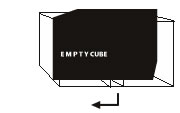RITA GT
MARCH, 13, 2009

CONTACTS
ritaguedestavares@gmail.com
EXHIBITION INFORMATION
ONE NIGHT EVENT
Instalation
2009
Vídeo, 2 projecções, cor, som, 14''28'
Guided tour.
This project by artist RitaGT prolongs the rebellious stance and intervenient posture that characterise the strategy of her work. Her form of intervention sometimes includes a controversial tone and a brazen attention to systematisation and classification processes drawn from the intellectual models that have defined our cultural and political identity between the late 1800s and early 1900s. The artist employs various devices, such as language, photography or interaction with the public, with a strong performative and self-referential slant, to explore various itineraries and discourses from art history.
It is within this context that the project presented at EMPTY CUBE becomes invested with a double meaning. First of all, its title, written in three European languages, takes on a polyphonic character, as if three distinct voices combined into a harmonious final form that conveys the same meaning, which is indeed the case when we read the title in print. However, this harmonious combination is simultaneously subjected to an action that forces us to re-read that same title, part of which has been crossed out and rewritten by the artist herself to turn One-night event into One-life event, with similar changes made to the Portuguese and German versions of the phrase. This semantic play evokes some issues featured in her work, like identity or the notion of belonging. RitaGT lives in Berlin, she is Portuguese and uses a globalised and universal idiom, the English language. On the other hand, her contribution to EMPTY CUBE subverts the “single presentation” policy that characterises this exhibitive project by pointedly replacing “night” with “life”. The subtle system of relationships contained in the title takes us to a wider field of action: the construction of collective memory, explored via the recording of a work on video and in the printing of a book, limited to two hundred copies.
Video projections document a performative action in which the artist, wearing the traditional working-clothes of a Viana do Castelo woman harvester, walks through several rooms in four museums in the city of Berlin. The exhibits in the rooms describe a temporal and geographic arc, as if she were circumnavigating through various periods in human history. The apparel worn by the artist can be read as a universal symbol, a referent identifying the culture to which its wearer belongs. In turn, the pictures printed in the book confront us with the presence of a body, sitting on a bench in a museum room. RitaGT reverses the meaning and use of this piece of furniture, using it as a plinth to display a depiction of herself, petrified in the moment of its exhibition. The textual fragments in the book interweave quotes from historians and notes by the artist, examining such controversial issues as the appropriation and decontextualisation of other cultures through the possession of objects characteristic of them, as well as the historical periods, such as colonialism and modernism, in which such actions took place. Thus, collective memory and confrontation with our cultural and political legacy find their place in the museum as a construction device of history, as a contact and confrontation zone.
RitaGT embodies a character who sets off on a kind of panoramic journey, a corrosive commentary on the history of the power relations between centre and periphery.
João Silvério
March 2009





